Scott Girolmo
Offensive Coordinator
Liberty High School (VA)
Twitter: @CoachGirolmo
At Liberty High School, we are a multiple offense that utilizes a number of personnel groupings, and a very wide array of formational sets. From these formations we utilize multiple man, zone and gap run schemes and 6 and 7 man pass protections. Finally, we have combined these schemes with both traditional I back / single back backfield movements, and contemporary shotgun multi-read backfield movements.
This is a lot of offense. We understand that, but we do it for one simple purpose: to attack the defense. We are constantly drawing, debating, and adapting our scheme to better fit our personnel. One of these adaptations, the "Orbit" motion, has been an integral component to our attack.
Our prior offense here at Liberty was orchestrated by then Head Coach Tommy Buzzo, and our current Head Coach Sean Finnerty. Their offensive package was tremendously dynamic, with a myriad of shifts, motions and swiftly attacking run schemes that worked like focused jabs to weaken the defense for a knockout haymaker. One of the signature plays within the offense was the classic "rocket sweep" utilized by flexbone-heavy offenses [Diagrams 1&2]. In our attempt to adapt the best concepts of the former offense to the completely new package we installed this past spring, the idea of utilizing a pre-snap movement that was abrupt and lateral to "outflank" the defense was a major priority. From my previous experience I had developed a particular affinity for both flexbone option football, and a variation of the spread I - multiple offense developed in the early 2000’s by Wake Forest O.C. Steed Lobotzke which was heavy in Orbit motion (He credits University of Minnesota coach Glenn Mason for running it first in 1999 in a game they coached against one another). Therefore, a perfect marriage was conceived.
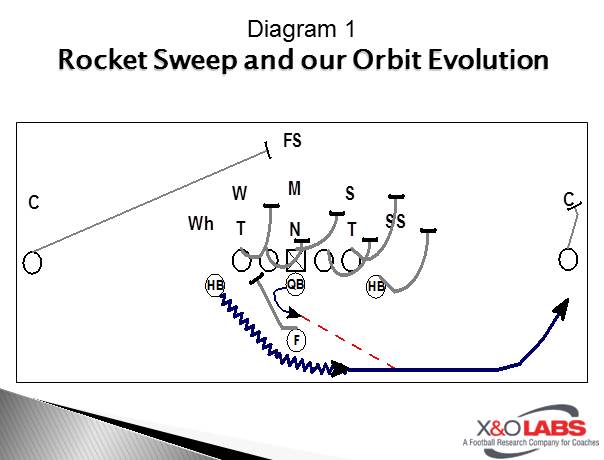
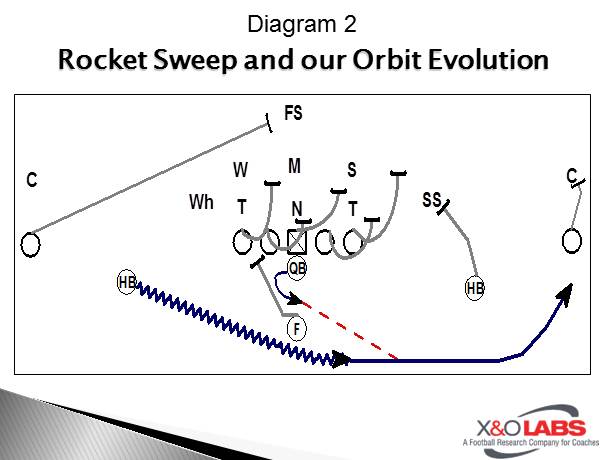
Football is the greatest sport for so many reasons, but one of my favorites is that the simplest of concepts or fundamental skills can have innumerable names, appearances, or philosophies behind it depending on who is teaching. For us, Orbit motion is a perimeter player (tight slot or wing) motioning across and behind the deepest back in the backfield. The two variations of Orbit are taught simultaneously.
On the first day of its installation, our players are taught to motion flat towards the interior of the formation from their alignment building speed as they go. As they enter the tackle box, they are to "spring" off of their foot closest to the LOS and attack behind the deepest back, controlling their speed to achieve the position desirable for the particular play called at the moment of the snap [Diagram 3]. We condense that rhetoric for our players by teaching them to "run the arc." If they are aligned in a tight slot, or wing position, we teach them to run the arc from that spot [Diagram 4].
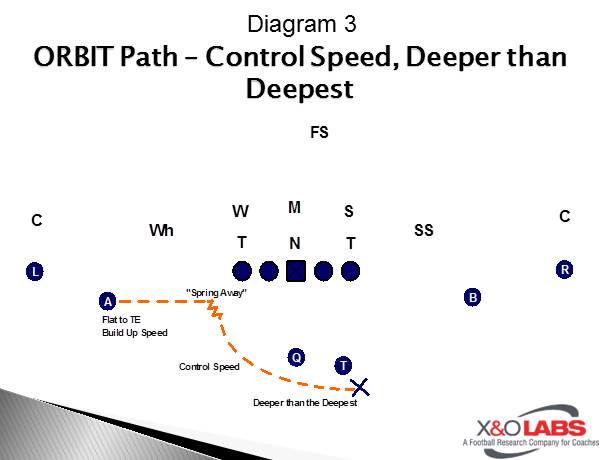
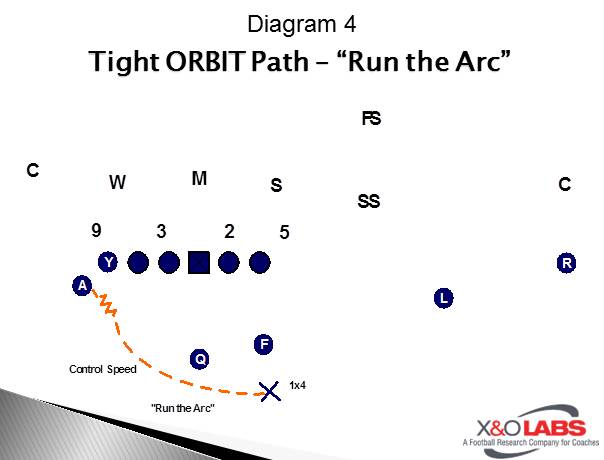
Experience has taught us that our teaching is more effective when explain our concepts from the ref’s whistle backward. In each scenario we explain to the player that their motion should put them in position to accomplish one of three outcomes:
With the end result established, we can then move on to explain why they are in the position for each of the three outcomes above. Here is a more detailed look at how we teach each outcome:
Pitch: In the instance that they are motioning to become the pitch man, we are attempting to attack a numbers advantage in the defense’s run-support scheme. By motioning across the formation, we can both attack the defenses flank by pitching the ball, and force a distortion in their run-fits which will create a favorable match-up or running lane [Diagram 5&6].
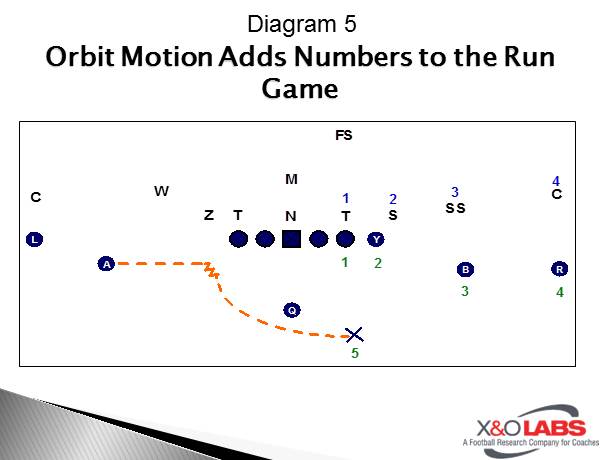
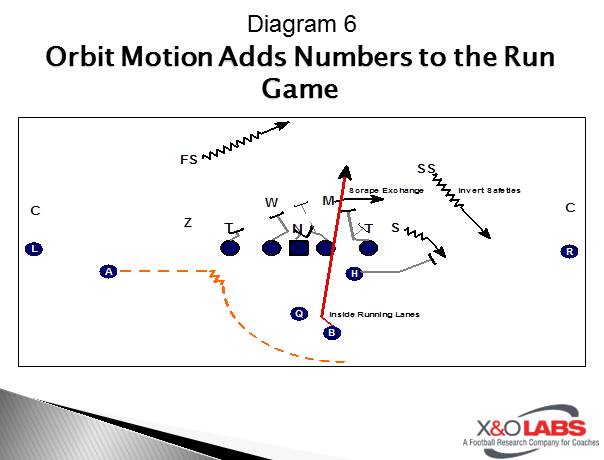
Swing Route: When a pass is called, we utilize the orbit motion for several reasons. The first is to gain a swiftly expanding flat-route to provide a check-down, or what we call "rush" route for our QB. The next reason the player runs a swing route is to win the numbers advantage against the defenses coverage scheme. By adding one more receiver to their defenders in coverage, we may be able to free someone up [Diagram 7]. In addition, the Orbit Swing is to create conflict in the defensive secondary’s eye/read progression, and create space for a front-side or back-side deep route (what we call ‘rhythm’ throws).
Offensive Coordinator
Liberty High School (VA)
Twitter: @CoachGirolmo
At Liberty High School, we are a multiple offense that utilizes a number of personnel groupings, and a very wide array of formational sets. From these formations we utilize multiple man, zone and gap run schemes and 6 and 7 man pass protections. Finally, we have combined these schemes with both traditional I back / single back backfield movements, and contemporary shotgun multi-read backfield movements.
This is a lot of offense. We understand that, but we do it for one simple purpose: to attack the defense. We are constantly drawing, debating, and adapting our scheme to better fit our personnel. One of these adaptations, the "Orbit" motion, has been an integral component to our attack.
The Evolution
Our prior offense here at Liberty was orchestrated by then Head Coach Tommy Buzzo, and our current Head Coach Sean Finnerty. Their offensive package was tremendously dynamic, with a myriad of shifts, motions and swiftly attacking run schemes that worked like focused jabs to weaken the defense for a knockout haymaker. One of the signature plays within the offense was the classic "rocket sweep" utilized by flexbone-heavy offenses [Diagrams 1&2]. In our attempt to adapt the best concepts of the former offense to the completely new package we installed this past spring, the idea of utilizing a pre-snap movement that was abrupt and lateral to "outflank" the defense was a major priority. From my previous experience I had developed a particular affinity for both flexbone option football, and a variation of the spread I - multiple offense developed in the early 2000’s by Wake Forest O.C. Steed Lobotzke which was heavy in Orbit motion (He credits University of Minnesota coach Glenn Mason for running it first in 1999 in a game they coached against one another). Therefore, a perfect marriage was conceived.


Orbit Defined
Football is the greatest sport for so many reasons, but one of my favorites is that the simplest of concepts or fundamental skills can have innumerable names, appearances, or philosophies behind it depending on who is teaching. For us, Orbit motion is a perimeter player (tight slot or wing) motioning across and behind the deepest back in the backfield. The two variations of Orbit are taught simultaneously.
On the first day of its installation, our players are taught to motion flat towards the interior of the formation from their alignment building speed as they go. As they enter the tackle box, they are to "spring" off of their foot closest to the LOS and attack behind the deepest back, controlling their speed to achieve the position desirable for the particular play called at the moment of the snap [Diagram 3]. We condense that rhetoric for our players by teaching them to "run the arc." If they are aligned in a tight slot, or wing position, we teach them to run the arc from that spot [Diagram 4].


Teaching Progression:
- End Result
- Why
- Communication
- Execution
End Result
Experience has taught us that our teaching is more effective when explain our concepts from the ref’s whistle backward. In each scenario we explain to the player that their motion should put them in position to accomplish one of three outcomes:
- Motion player is the Pitch Man
- Motion player is the Swing Route
- Motion player is a decoy.
Why
With the end result established, we can then move on to explain why they are in the position for each of the three outcomes above. Here is a more detailed look at how we teach each outcome:
Pitch: In the instance that they are motioning to become the pitch man, we are attempting to attack a numbers advantage in the defense’s run-support scheme. By motioning across the formation, we can both attack the defenses flank by pitching the ball, and force a distortion in their run-fits which will create a favorable match-up or running lane [Diagram 5&6].


Swing Route: When a pass is called, we utilize the orbit motion for several reasons. The first is to gain a swiftly expanding flat-route to provide a check-down, or what we call "rush" route for our QB. The next reason the player runs a swing route is to win the numbers advantage against the defenses coverage scheme. By adding one more receiver to their defenders in coverage, we may be able to free someone up [Diagram 7]. In addition, the Orbit Swing is to create conflict in the defensive secondary’s eye/read progression, and create space for a front-side or back-side deep route (what we call ‘rhythm’ throws).









